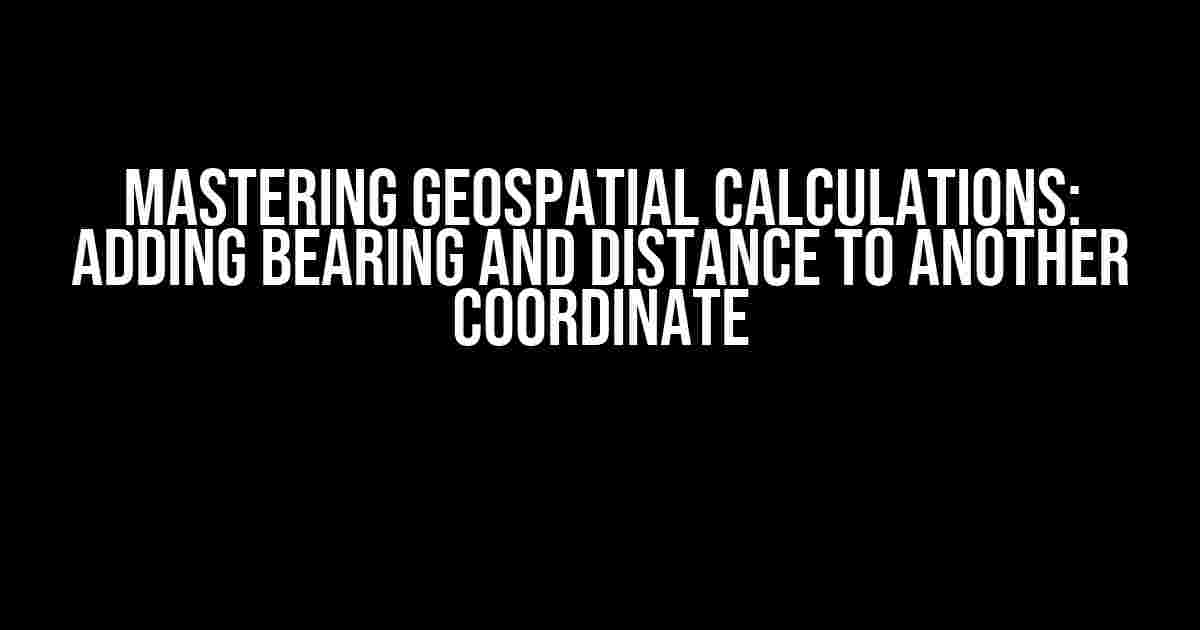Are you tired of struggling with geospatial calculations? Do you find yourself lost in a sea of coordinates and bearings? Fear not, dear reader, for today we’re going to demystify the process of adding a bearing and distance to another coordinate. By the end of this article, you’ll be a pro at calculating new coordinates with ease!
Understanding the Basics: What is a Bearing?
A bearing is a direction or angle measured clockwise from North. It’s essential in navigation, mapping, and geospatial calculations. Bearings can be expressed in degrees, with 0° being North, 90° being East, 180° being South, and 270° being West. To add a bearing to another coordinate, you need to understand how to work with these angles.
The Formula: Add Bearing (WITH N, S, E, W) AND DISTANCE (M) TO ANOTHER COORDINATE (LAT, LON)
new_lat = old_lat + (distance * sin(bearing * π/180)) / 111320 new_lon = old_lon + (distance * cos(bearing * π/180)) / (111320 * cos(old_lat * π/180))
Don’t let the formula intimidate you! Let’s break it down into manageable parts:
old_latandold_lonare the original coordinates.bearingis the direction or angle measured clockwise from North, in degrees.distanceis the distance to be added, in meters.new_latandnew_lonare the resulting coordinates after adding the bearing and distance.
Step-by-Step Instructions: Adding Bearing and Distance
Follow these steps to add a bearing and distance to another coordinate:
- Convert the bearing to radians: Multiply the bearing in degrees by π/180.
- Calculate the change in latitude: Multiply the distance by the sine of the bearing (in radians). Divide the result by 111320.
- Calculate the change in longitude: Multiply the distance by the cosine of the bearing (in radians). Divide the result by (111320 * cosine of the original latitude in radians).
- Add the changes to the original coordinates: Add the change in latitude to the original latitude, and add the change in longitude to the original longitude.
Example Calculation: Adding 30° Bearing and 1000m Distance
Let’s say you want to add a 30° bearing and 1000m distance to the coordinate (43.6532, -79.3832).
| Original Coordinates | Value |
|---|---|
| Latitude (old_lat) | 43.6532 |
| Longitude (old_lon) | -79.3832 |
| Bearing (degrees) | 30 |
| Distance (m) | 1000 |
bearing_rad = 30 * π/180 = 0.5236 rad change_in_lat = 1000 * sin(0.5236) / 111320 = 0.0043 change_in_lon = 1000 * cos(0.5236) / (111320 * cos(43.6532 * π/180)) = 0.0065 new_lat = 43.6532 + 0.0043 = 43.6575 new_lon = -79.3832 + 0.0065 = -79.3767
The resulting coordinates are (43.6575, -79.3767).
Common Pitfalls and Considerations
When working with geospatial calculations, it’s essential to be mindful of the following:
- Units matter! Ensure that all distances are in the same unit, and angles are in degrees or radians.
- Latitude and longitude have different scales: The distance represented by 1° of latitude is not equal to the distance represented by 1° of longitude.
- Beware of datum and ellipsoid differences: Different mapping systems use various datum and ellipsoids, which can affect coordinate calculations.
- Account for precision and rounding errors: Geospatial calculations can be sensitive to small errors, so ensure you’re using sufficient precision and rounding correctly.
Conclusion
With this comprehensive guide, you’re now equipped to add bearings and distances to another coordinate like a pro! Remember to carefully consider the units, scales, and potential pitfalls to ensure accurate results. Practice makes perfect, so go ahead and start calculating those coordinates!
Stay tuned for more geospatial goodness and remember to share your newfound knowledge with the world!
Additional Resources
Happy calculating!
Frequently Asked Question
Get ready to ace your coordinates game with these burning questions and their expert-approved answers!
What is the concept of adding bearing and distance to another set of coordinates?
Adding bearing and distance to another set of coordinates means calculating new coordinates by moving in a specific direction (bearing) for a certain distance from the initial coordinates. It’s like giving your coordinates a makeover with a new direction and distance!
How do I represent the bearing in my calculation?
The bearing is typically represented in degrees, ranging from 0° to 360°, with 0° being North, 90° being East, 180° being South, and 270° being West. For example, if you want to add a bearing of 45°, it means you’ll be moving in a northeast direction!
What is the formula to calculate the new coordinates?
The formula to calculate the new coordinates is a bit math-y, but don’t worry, we got you! It’s: lat2 = lat1 + (distance * sin(-bearing) / (111320 * cos(lat1))); lon2 = lon1 + (distance * cos(bearing) / (111320 * cos(lat1))). Plug in the values, and voilà! You’ll get your new coordinates!
What unit is the distance typically measured in?
The distance is usually measured in meters (m). So, if you want to add 500 meters to your initial coordinates, you’ll be moving approximately 0.5 kilometers in the specified direction!
Are there any tools or libraries that can help me with these calculations?
Yes, there are many tools and libraries that can simplify these calculations for you! For example, you can use programming languages like Python with libraries like geopy or pyproj, or online tools like GeoCalculator or LatLongCalc. They’ll do the math for you, so you can focus on the fun part – exploring your new coordinates!

